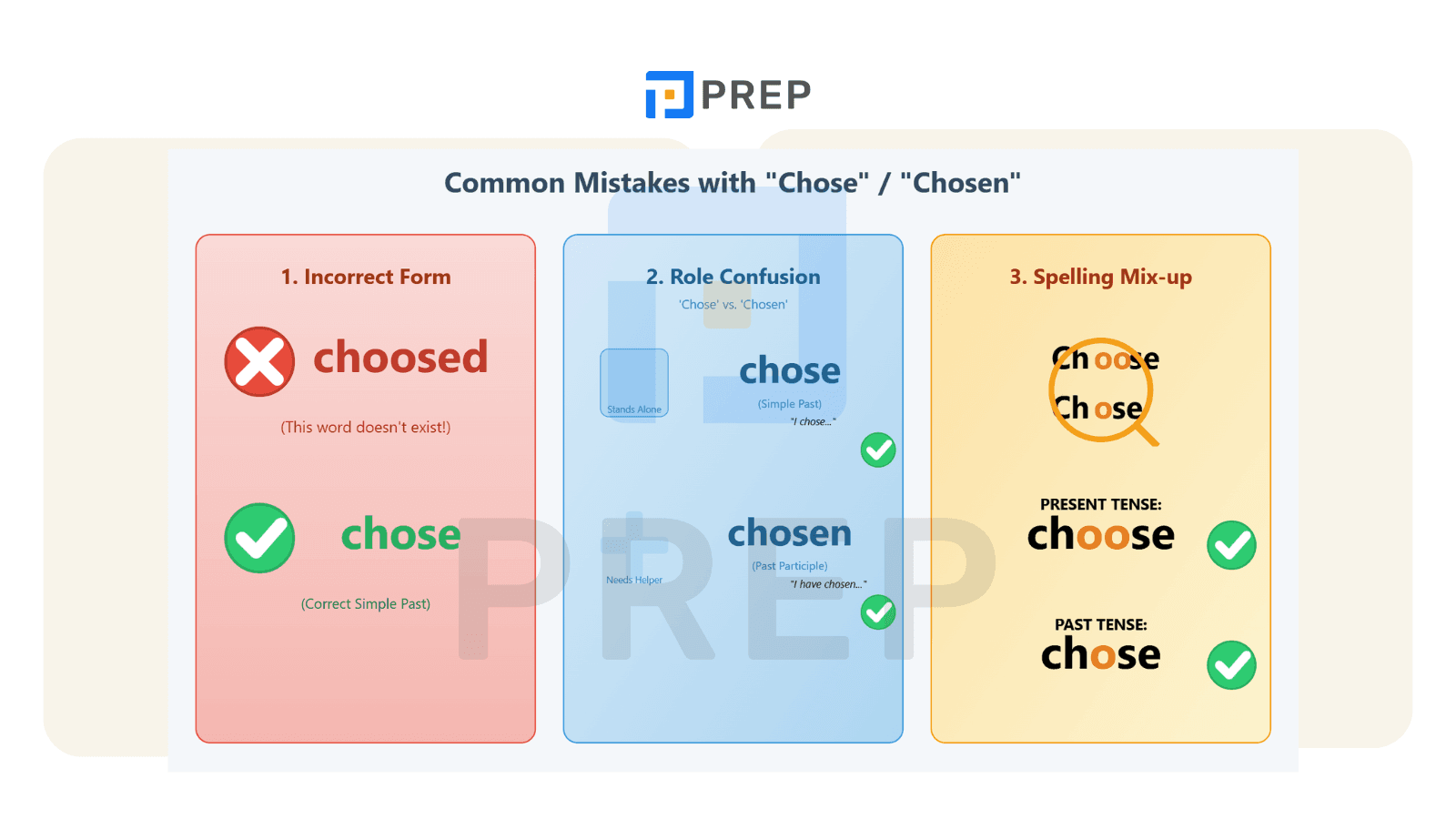Understanding and Using The Past Tense of Choose Correctly
This comprehensive guide addresses one of the most common grammatical challenges in English: mastering the past tense of Choose. The content systematically explains the distinction between "chose" (simple past tense) and "chosen" (past participle), providing clear usage rules, practical examples, and strategies to avoid frequent errors. The article covers fundamental definitions, contextual applications, comparative analysis, common mistakes, memory techniques, and vocabulary expansion. It serves as a definitive resource for learners seeking to eliminate confusion around irregular verb conjugation and achieve grammatical accuracy in their English communication.
- 1. The Simple Past Tense of Choose
- 2. The critical distinction between 'Chose' vs. 'Chosen'
- 3. Mastering 'Chose' in Sentences
- 4. Avoiding Common Mistakes: Ensuring Accurate Use of 'Chose'
- 5. Expanding Your Understanding: Further Questions Answered
- 5.1. Is 'chose' considered formal or informal English?
- 5.2. What exactly does "irregular verb" mean in relation to 'choose'?
- 5.3. What are some other common English verbs with similar irregular past tense patterns?
- 5.4. How does the meaning of 'chose' differ slightly from synonyms like 'selected' or 'picked' in the past tense?

1. The Simple Past Tense of Choose
The simple past tense of Choose is unequivocally "chose." This is the only correct form for expressing a completed selection or decision in the past tense without any auxiliary verbs. When discussing a selection that occurred and completed at a specific time in the past, "chose" is always the proper form to use. No alternative forms exist for the simple past tense of this verb.
|
Form |
Conjugation |
|
Base Form |
choose |
|
Present Simple (3rd person) |
chooses |
|
Simple Past |
chose |
|
Past Participle |
chosen |
|
Present Participle |
choosing |

2. The critical distinction between 'Chose' vs. 'Chosen'
The past tense of choose verb creates confusion because it looks similar to the past participle but serves a different purpose. Using the incorrect form can change the meaning of your sentence or create confusion for listeners and readers. Mastering this distinction demonstrates precision in your English communication skills and reflects a deeper understanding of English grammar structures.
2.1. Understanding 'Chose': The Simple Past Tense
"Chose" functions specifically as the past tense of choose. It represents a direct, straightforward way to describe completed actions that occurred at a definite time in the past. The choose past simple form differs from regular verbs that simply add "-ed" to form the past tense. Instead, "choose" transforms into "chose" through an internal vowel change, reflecting its status as an irregular verb.
2.2.1. Function: Describing a Completed Action in the Past
"Chose" indicates a single, finished action that happened before the present moment. It places the act of choosing firmly in the past without connecting it to the present time. This clarity helps establish a precise timeline in communication using the past tense of choose.
2.2.2. Usage Rule: Used Alone (Without Helping Verbs)
"Chose" stands independently after the subject without requiring auxiliary verbs. The standard structure follows the pattern: Subject + chose + object. This contrasts with other past forms that require helper verbs to create meaning.
For example:
-
I chose my words carefully.
-
They chose to travel by train.
2.2. Understanding 'Chosen': The Past Participle
"Chosen" serves as the choose past participle form. This form plays a different grammatical role than the simple past tense and appears in more complex verb constructions. Understanding when to use "chosen" rather than "chose" requires recognizing specific grammatical contexts.
2.2.1. Function: Used in Perfect Tenses and Passive Voice
"Chosen" appears primarily in perfect tenses (have/has/had + chosen) to connect past actions to other time periods. The choose past perfect tense (had chosen) indicates an action completed before another past action. It also forms passive voice constructions (be + chosen) where the focus shifts to the recipient of an action rather than the performer. These structures create more nuanced temporal relationships than the simple past.
2.2.2. Usage Rule: Requires Helping Verbs (have, has, had, am, is, are, was, were)
Unlike "chose," which stands alone, "chosen" must always pair with an auxiliary or helping verb to create meaning. The most common helping verbs include forms of "have" (for perfect tenses) and forms of "be" (for passive voice). The choose past tense and past participle forms serve different grammatical functions despite both relating to past time.
For example:
-
Perfect Tense: We have chosen our seats.
-
Passive Voice: The winner was chosen unanimously.
2.3. Comparison table: 'Chose' vs. 'Chosen'
To solidify your understanding, let's compare these two forms directly based on their grammatical features and usage patterns.
|
Feature |
Chose |
Chosen |
|
Grammar Term |
Simple Past Tense |
Past Participle |
|
Usage |
Used alone after subject |
Requires helping verbs |
|
Time Reference |
Specific past time |
Various (perfect tenses/passive) |
|
Example |
"I chose the red one." |
"I have chosen the red one." |
3. Mastering 'Chose' in Sentences
3.1. Building Affirmative Sentences with 'Chose'
Creating affirmative statements with "chose" follows the standard English Subject-Verb-Object pattern. The subject performs the action of choosing (expressed through "chose") directed toward an object or outcome. This straightforward structure works universally with all subject types when using the past tense of choose.
Examples with Different Subjects:
-
I chose the vanilla ice cream over chocolate.
-
You chose wisely when you invested in that company.
-
He chose to remain silent during the interrogation.
-
We chose the scenic route for our road trip.
-
They chose three representatives from each department.
3.2. Forming Negative Sentences (Using 'Did Not Choose')
To create negative statements in the past tense, English requires the auxiliary verb "did" plus "not" followed by the base form "choose" (not "chose"). This pattern reflects a fundamental rule of English: when using the auxiliary "did" to form negatives or questions, the main verb reverts to its base form.
3.2.1. Correct Structure: Subject + did not + choose + ...
3.2.2. Example: "He did not choose the easy option."
3.3. Asking Questions about Past Choices (Using 'Did... Choose?')
When forming questions about past choices, English again requires the auxiliary verb "did" positioned before the subject, followed by the base form "choose." The auxiliary verb carries the past tense of choose marker, allowing the main verb to remain in its base form.
3.3.1. Correct Structure: Did + subject + choose + ...?
3.3.2. Example: "Did they choose the venue?"

4. Avoiding Common Mistakes: Ensuring Accurate Use of 'Chose'
4.1. Mistake #1: Using the Incorrect Form "Choosed"
One frequent error among English learners involves applying regular verb rules to "choose" by adding "-ed" to create "choosed." This form does not exist in standard English. The correct past tense of choose is always "chose," without exception.
Explanation: 'Choose' is Irregular
"Choose" belongs to the class of irregular verbs that change form internally rather than adding endings. Learning these irregular forms requires specific attention and practice rather than applying general rules.
4.2. Mistake #2: Confusing 'Chose' and 'Chosen'
Many learners struggle with determining whether to use "chose" or "chosen" in a sentence. Remember the fundamental distinction: "chose" stands alone as the simple past tense, while "chosen" requires a helping verb and functions as the past participle.
Reminder: 'Chosen' Needs a Helper Verb
Incorrect: "She chosen the red dress." Correct: "She chose the red dress." (simple past) Correct: "She has chosen the red dress." (present perfect with helper verb "has")
Understanding this distinction between choose past tense and past participle forms prevents common errors in your writing and speaking.
4.3. Mistake #3: Spelling Errors (Chose vs. Choose)
The spelling difference between present tense "choose" (with double "o") and past tense "chose" (with single "o") creates another common error point for English learners and even native speakers when writing quickly.
Tip: Link 'Chose' (one 'o') to the Past
A helpful memory device: "Chose" has one "o" for one time in the past; "choose" has two "o"s for recurring or present actions. This simple rule helps you correctly spell the past tense of choose.

5. Expanding Your Understanding: Further Questions Answered
5.1. Is 'chose' considered formal or informal English?
The past tense of choose belongs to standard English and works appropriately in both formal and informal contexts. It represents the neutral, accepted past tense form of "choose" across all registers of English. Unlike some verbs that have formal and informal variants, "chose" maintains its status in academic writing, business communication, and casual conversation alike. This versatility makes it a valuable verb form to master.
5.2. What exactly does "irregular verb" mean in relation to 'choose'?
An irregular verb changes form in unpredictable ways rather than following the standard pattern of adding "-ed" for past tense forms. The past tense of choose verb exemplifies this irregularity by transforming to "chose" (past tense) and "chosen" (past participle) through internal vowel changes rather than suffixation. These irregular patterns typically developed from ancient language forms and must be memorized individually rather than derived from rules.
5.3. What are some other common English verbs with similar irregular past tense patterns?
Several common English verbs follow vowel-change patterns similar to "choose/chose/chosen." These include: "speak/spoke/spoken," "freeze/froze/frozen," "break/broke/broken," "drive/drove/driven," and "write/wrote/written." Recognizing these pattern groups can help learners anticipate irregular forms rather than memorizing each verb in isolation. These verbs often share historical linguistic origins with the past tense of choose.
5.4. How does the meaning of 'chose' differ slightly from synonyms like 'selected' or 'picked' in the past tense?
While "chose," "selected," and "picked" all describe past selection actions, they carry subtle connotative differences. "Chose" suggests a deliberate decision among options, often implying personal preference or judgment. "Selected" typically conveys a more formal, methodical process with criteria-based evaluation. "Picked" tends toward informality, sometimes suggesting a more casual or quick selection. These nuances allow precise expression depending on context when using the past tense of choose.
Understanding irregular verbs like "choose" represents a significant step in mastering English grammar. The confidence you gain from correctly using past tense of choose will enhance both your written and spoken communication. Continue practicing these distinctions in your daily language use, and consider exploring PREP's comprehensive grammar resources to further refine your English skills. With consistent application, what once seemed confusing will become second nature in your journey toward English fluency.

Hi I'm Chloe, and I am currently serving as an Product Content Administrator at Prep Education. With over five years of experience in independent online IELTS study and exam preparation, I am confident in my ability to support learners in achieving their highest possible scores.
Comment
Premium content
View allPersonalized roadmap
Most read












